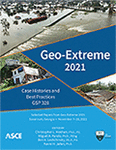Evaluation of Pore Water Pressure Prediction Methods under Rapid Drawdown: Case Study of the Pilarcitos Dam Failure
Publication: Geo-Extreme 2021
ABSTRACT
Work in this study utilizes coupled, partially coupled, and uncoupled transient seepage analysis approaches to investigate the Pilarcitos Dam failure due to the rapid drawdown (RDD) condition. The Pilarcitos Dam is modeled using the finite-element (FE) software PLAXIS utilizing nonlinear advanced elastic–plastic constitutive relation. The modeled embankment is subjected to rapid drawdown, and the stability factor of safety (FS) is determined using the strength reduction method (SRM). The uncoupled seepage/stability approach is also applied whereas the partially coupled seepage analysis and the subsequent stability analysis are performed using FE program SEEP/W and limit equilibrium (LEM) software SLOPE/W, respectively. Results indicated that the use of coupled analyses leads to more realistic estimation of pore water pressures after RDD, as compared to the partially coupled and uncoupled analysis approaches. In this case, only the coupled analysis approach yielded representative FS and maximum depth of potential slip surface that reflect conditions observed for Pilarcitos Dam failure. In addition, the results indicated that the estimated time for complete dissipation of pore pressure after drawdown is significantly higher for uncoupled and partially coupled analyses as compared to the coupled analysis approach.
Get full access to this article
View all available purchase options and get full access to this chapter.
REFERENCES
Barrett, J. R., and Moore, P. J. (1975). Design criteria for rapid drawdown in earth-rock dams. Criteria and Assumptions for Numerical Analysis of Dams (pp. 809–828). Swansea, U.K.: Dept. of Civil Engineering of the Univ. College.
Berilgen, M. M. (2007). Investigation of stability of slopes under drawdown conditions. Computers and Geotechnics, 34(2), 81–91.
Bishop, A. W. (1954). The use of pore-pressure coefficients in practice. Geotechnique, 4(4), 148–152.
Duncan, J. M., Wright, S. G., and Wong, K. S. (1990). Slope stability during rapid drawdown. Seed Memorial Symposium (pp. 235–272). Vancouver, BC, Canada: BiTech Publishers.
Jadid, R., Montoya, B. M., Bennett, V., and Gabr, M. A. (2020). Effect of repeated rise and fall of water level on seepage-induced deformation and related stability analysis of Princeville levee. Engineering Geology, 266, 105458.
Obrzud, R. F., and Truty, A. (2018). The Hardening Soil Model-A practical Guidebook. Preverenges, Switzerland: Zace Services Ltd.
Pinyol, N. M., Alonso, E. E., and Olivella, S. (2008). Rapid drawdown in slopes and embankments. Water Resources Research banner, 44(5), 1–22.
Plaxis. (2016). Plaxis 2D reference manual. Delft, Netherlands: Plaxis.
Schanz, T., Vermeer, P. A., and Bonnier, P. G. (1999). The hardening soil model: Formulation and verification. Beyond 2000 in computational geotechnics—10 Years of PLAXIS, (pp. 1–16). Balkema, Rotterdam, Netherlands.
Spencer, E. (1967). A Method of Analysis of the Stability of Embankments Assuming Parallel Interslice Forces. Geotechnique, 17(1), 11–26.
van Genuchten, M. T. (1980). A closed-form equation for predicting the hydraulic conductivity of unsaturated soils. Soil Science Society of America Journal, 44(5), 892–898.
VandenBerge, D. R. (2014a). Rapid Drawdown Analysis using the Finite Element Method. PhD Thesis, Virginia Polytechnic Institute and State University, Civil Engineering, Blacksburg, VA.
Vandenberge, D. R. (2014b). Total stress rapid drawdown analysis of the Pilarcitos Dam failure using the finite element method. Frontiers of Structural and Civil Engineering, 8, 115–123.
VandenBerge, D. R., Duncan, J. M., and Brandon, T. L. (2015). Limitations of transient seepage analyses for calculating pore pressures during external water level changes. Journal of Geotechnical and Geoenvironmental Engineering, 141(5), 04015005.
Wahler, W. A., et al. (1970). Upstream slope drawdown failure investigation and remedial measures, Pilarcitos Dam. Rep. to San Francisco Water Department, San Francisco.
Wong, K. S., Duncan, J. M., and Seed, H. B. (1983). Comparison of methods of rapid drawdown stability analysis. Berkeley, CA, Dept. of Civil Engineering, Univ. of California.
Information & Authors
Information
Published In
Copyright
© 2021 American Society of Civil Engineers.
History
Published online: Nov 4, 2021
Authors
Metrics & Citations
Metrics
Citations
Download citation
If you have the appropriate software installed, you can download article citation data to the citation manager of your choice. Simply select your manager software from the list below and click Download.
